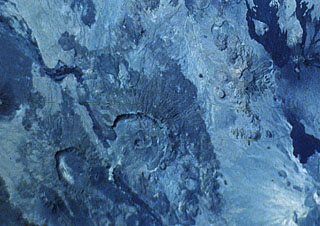Report on Nabro (Eritrea) — 8 June-14 June 2011
Smithsonian Institution / US Geological Survey
Weekly Volcanic Activity Report, 8 June-14 June 2011
Managing Editor: Sally Sennert.
Please cite this report as:
Global Volcanism Program, 2011. Report on Nabro (Eritrea) (Sennert, S, ed.). Weekly Volcanic Activity Report, 8 June-14 June 2011. Smithsonian Institution and US Geological Survey.
Nabro
Eritrea
13.37°N, 41.7°E; summit elev. 2218 m
All times are local (unless otherwise noted)
According to the USGS Earthquake Hazards Program, an earthquake swarm was detected during the evening of 12 June on the border of Ethiopia and Eritrea, in the vicinity of Nabro, the most prominent of three volcanoes with large summit calderas aligned in a NE-SW direction SW of Dubbi volcano. The swarm began at 1837 with an M 5.1 earthquake. Several more were detected between M 4.3 and 5.1 over the next few hours. Two M 5.7 earthquakes at depths of 10.1 km and 9.9 km were detected at 2332 on 12 June and 0003 on 13 June, respectively.
The Toulouse VAAC reported that an eruption from Nabro (originally attributed to Dubbi) started between 0000 and 0200 on 13 June. An eruption plume initially rose to altitudes of 9.1-13.7 km (30,000-45,000 ft) a.s.l. then was later detected at altitudes of 6.1-10.7 km (20,000-35,000 ft) a.s.l. during 13-14 June. According to the Eritrean Ministry of Information, ashfall covered hundreds of kilometers and the government evacuated area residents. Witnesses noted that the eruption had started at about 2100 on 13 June. Satellite images that same day showed the plume drifting more than 1,000 km NW, over parts of Sudan. On 14 June a detached ash cloud was detected over southern Israel according to news articles. A plume from Nabro was not obvious on satellite imagery.
Geological Summary. The Nabro stratovolcano is the highest volcano in the Danakil depression of northern Ethiopia and Eritrea, at the SE end of the Danakil Alps. Nabro, along with Mallahle, Asavyo, and Sork Ale volcanoes, collectively comprise the Bidu volcanic complex SW of Dubbi volcano. This complex stratovolcano constructed primarily of trachytic lava flows and pyroclastics, is truncated by nested calderas 8 and 5 km in diameter. The larger caldera is widely breached to the SW. Rhyolitic obsidian domes and basaltic lava flows were erupted inside the caldera and on its flanks. Some very recent lava flows were erupted from NNW-trending fissures transverse to the trend of the volcanic range.
Sources: NASA MODIS Rapid Response System, The Jerusalem Post, Eritrean Ministry of Information, Toulouse Volcanic Ash Advisory Centre (VAAC), US Geological Survey Earthquake Hazards Program

